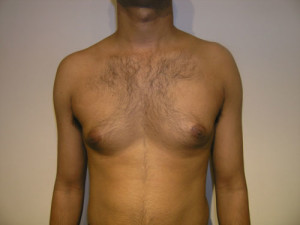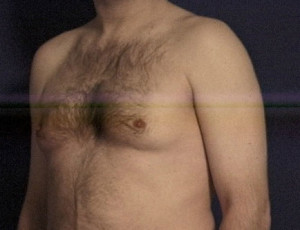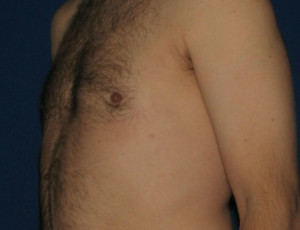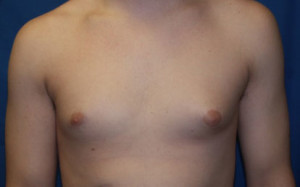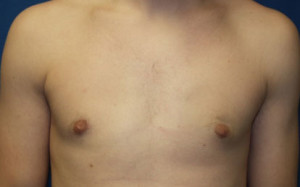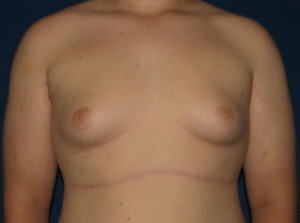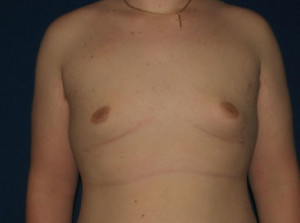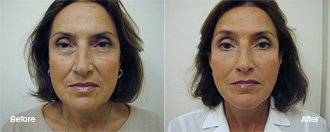Male Breast Reduction New York City
Male breast Reduction (GYNECOMASTIA)
 Gynecomastia is an enlargement of the breasts in males. It is fairly common, occurring in as much as 10% of the male population and is often a source of self-consciousness, embarrassment and psychological stress and feelings of un-manliness. It usually starts in adolescence and can affect either one or both breasts. It is usually not associated with abnormal hormone levels nor elevated female hormone levels but these are often checked before corrective surgery. Older males may develop gynecomastia as a side effect of certain medications as well as with the natural reduction in testosterone. Enlarged breasts in the male may be composed of fatty tissue, true breast tissue or a combination of both. The last is most common. In overweight adolescent males, the enlarged breasts can be composed of fat alone. In many such cases, diet and weight reduction may resolve and reverse the enlargement while it may have no or minimal effect in other individuals. However, some males have true breast tissue which can be tender and painful. Depending on the makeup of the breast tissue (fat, breast tissue or both), gynecomastia is treated either by liposuction alone which is the more common approach, by surgical excision or a combination of both. When there is a large amount of sagging or redundant skin, excision of skin may be the only alternative addition to the procedure.
Gynecomastia is an enlargement of the breasts in males. It is fairly common, occurring in as much as 10% of the male population and is often a source of self-consciousness, embarrassment and psychological stress and feelings of un-manliness. It usually starts in adolescence and can affect either one or both breasts. It is usually not associated with abnormal hormone levels nor elevated female hormone levels but these are often checked before corrective surgery. Older males may develop gynecomastia as a side effect of certain medications as well as with the natural reduction in testosterone. Enlarged breasts in the male may be composed of fatty tissue, true breast tissue or a combination of both. The last is most common. In overweight adolescent males, the enlarged breasts can be composed of fat alone. In many such cases, diet and weight reduction may resolve and reverse the enlargement while it may have no or minimal effect in other individuals. However, some males have true breast tissue which can be tender and painful. Depending on the makeup of the breast tissue (fat, breast tissue or both), gynecomastia is treated either by liposuction alone which is the more common approach, by surgical excision or a combination of both. When there is a large amount of sagging or redundant skin, excision of skin may be the only alternative addition to the procedure.
 In the case of adolescence, Dr. Simone will review his findings and recommendations with the pediatrician or personal physician. Routine pre-operative testing will be done and pre-operative photographs taken as a guideline during treatment. Hormonal studies are rarely indicated as they are most often normal. It is best to be close to your reasonably maintainable weight. Of course, weight loss to within 5-10 lbs of your ideal is best. If that is not realistic, reduction can still be done and the appearance of the chest will improve with post-operative weight loss.
In the case of adolescence, Dr. Simone will review his findings and recommendations with the pediatrician or personal physician. Routine pre-operative testing will be done and pre-operative photographs taken as a guideline during treatment. Hormonal studies are rarely indicated as they are most often normal. It is best to be close to your reasonably maintainable weight. Of course, weight loss to within 5-10 lbs of your ideal is best. If that is not realistic, reduction can still be done and the appearance of the chest will improve with post-operative weight loss.
This procedure is done on an ambulatory basis either at Dr. Simone’s Park Plastic Surgery Center or at Lenox Hill Hospital. Anesthesia is usually local anesthesia with intravenous ‘twilight’ sedation administered by an anesthesiologist. If done by liposuction alone, the procedure is done through 2-3 small incisions placed in inconspicuous areas [side of chest, under arm]. Excess fat is removed using small canulas. If the tissue is made up primarily of breast tissue, which is firm and dense as opposed to fat, surgical excision may be the procedure of choice. This is generally done with an incision that goes half way around the nipple. The tissue is removed and the surrounding areas treated by liposuction for smooth transition areas. Following surgery, a moderately compressive garment is worn for 7-10 days.
Dr. Simone will review risks and complications which are usually uncommon occurrences. This may include but is not limited to infection, collection of fluid or blood, poor healing and variable sensory loss in the nipple, which is usually temporary.
Because of symptoms of breast and nipple pain and discomfort, heightened sensitivity as well as possible significant psychological and emotional reactions, this procedure may be reimburseable by insurance if such findings are documented. There is no guarantee however that insurance will cover the procedure.
Surgical correction of gynecomastia may well restore a young or even older male’s sense of manliness and rid him of embarrassment and the burden of feeling feminine. This procedure can be liberating in that it can allow the wearing of all kinds of garments [instead of trying to hide the enlarged breasts], allow young men to feel comfortable in taking their shirts off at the beach, swimming in pools, and participating in athletics and averting ridicule or teasing. Moreover, it can help, especially during young adulthood the normal development of intimate physical and sexual relationships without the sense of self-consciousness or being “feminine”.

